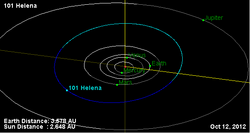Astronomy:101 Helena
 Orbital diagram | |
| Discovery | |
|---|---|
| Discovered by | James Craig Watson |
| Discovery date | 15 August 1868 |
| Designations | |
| (101) Helena | |
| Pronunciation | /ˈhɛlənə/[1] |
| Named after | Helen of Troy |
| A868 PA | |
| Minor planet category | Main belt |
| Orbital characteristics[2] | |
| Epoch 31 July 2016 (JD 2457600.5) | |
| Uncertainty parameter 0 | |
| Observation arc | 145.07 yr (52986 d) |
| |{{{apsis}}}|helion}} | 2.94606 astronomical unit|AU (440.724 Gm) |
| |{{{apsis}}}|helion}} | 2.22353 AU (332.635 Gm) |
| 2.58480 AU (386.681 Gm) | |
| Eccentricity | 0.13977 |
| Orbital period | 4.16 yr (1517.9 d) |
| Average Orbital speed | 18.44 km/s |
| Mean anomaly | 236.265° |
| Mean motion | 0° 14m 13.823s / day |
| Inclination | 10.1976° |
| Longitude of ascending node | 343.419° |
| 348.030° | |
| Earth MOID | 1.21369 AU (181.565 Gm) |
| Jupiter MOID | 2.4117 AU (360.79 Gm) |
| TJupiter | 3.387 |
| Physical characteristics | |
| Dimensions | 65.84±1.3 km[2] |
| Mass | 3.0×1017 kg |
| Mean density | 2.0 g/cm3 |
Equatorial surface gravity | 0.0184 m/s2 |
Equatorial escape velocity | 0.0348 km/s |
| Rotation period | 23.080 h (0.9617 d)[2] |
| Geometric albedo | 0.1898±0.008[2] |
| Physics | ~173 K |
| S[3] | |
| Absolute magnitude (H) | 8.33 |
Helena (minor planet designation: 101 Helena) is a large, rocky main-belt asteroid. It was discovered by Canadian-American astronomer J. C. Watson on August 15, 1868,[4] and was named after Helen of Troy in Greek mythology.
This object is orbiting the Sun with a period of 4.16 years and an eccentricity of 0.14. Its orbital plane is inclined by 10.2° to the plane of the ecliptic. Radar observations were made of this object on Oct 7 and 19, 2001 from the Arecibo Observatory. Analysis of the data gave an estimated ellipsoidal diameter of 71×63×63 ± 16% km. The mean diameter estimated from IRAS infrared measurements is 66 km, in agreement with the radar findings. It is classified as an S-type asteroid in the Tholen system,[3][5] suggesting a predominantly silicate composition. 101 Helena is spinning on its axis with a period of 23 hours.[2]
References
- ↑ Noah Webster (1884) A Practical Dictionary of the English Language
- ↑ 2.0 2.1 2.2 2.3 2.4 Yeomans, Donald K., "101 Helena", JPL Small-Body Database Browser (NASA Jet Propulsion Laboratory), https://ssd.jpl.nasa.gov/sbdb.cgi?sstr=101, retrieved 12 May 2016.
- ↑ 3.0 3.1 DeMeo, Francesca E. et al. (2011), "An extension of the Bus asteroid taxonomy into the near-infrared", Icarus 202 (1): 160–180, doi:10.1016/j.icarus.2009.02.005, Bibcode: 2009Icar..202..160D, archived from the original on 2014-03-17, https://web.archive.org/web/20140317200310/https://www.tara.tcd.ie/bitstream/2262/43276/1/PEER_stage2_10.1016/j.icarus.2009.02.005.pdf, retrieved 2013-03-22. See appendix A.
- ↑ "Numbered Minor Planets 1–5000", Discovery Circumstances (IAU Minor Planet center), https://www.minorplanetcenter.net/iau/lists/NumberedMPs000001.html, retrieved 2013-04-07.
- ↑ Magri, Christopher; Nolan, Michael C.; Ostro, Steven J.; Giorgini, Jon D. (January 2007), "A radar survey of main-belt asteroids: Arecibo observations of 55 objects during 1999 2003", Icarus 186 (1): pp. 126–151, doi:10.1016/j.icarus.2006.08.018, Bibcode: 2007Icar..186..126M.
External links
- 101 Helena at AstDyS-2, Asteroids—Dynamic Site
- 101 Helena at the JPL Small-Body Database
 |

